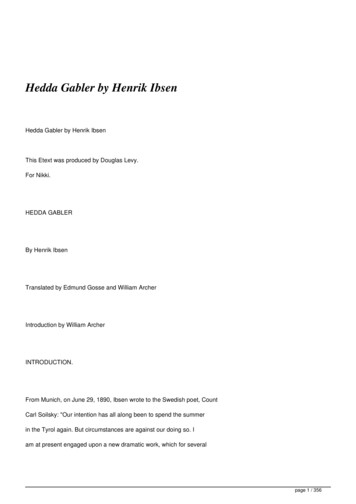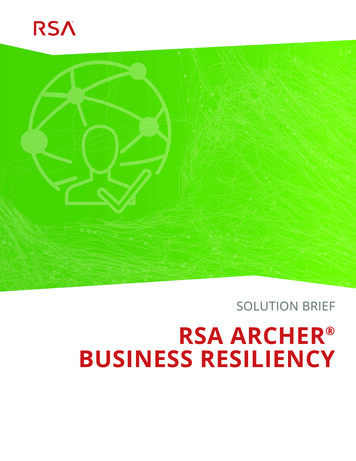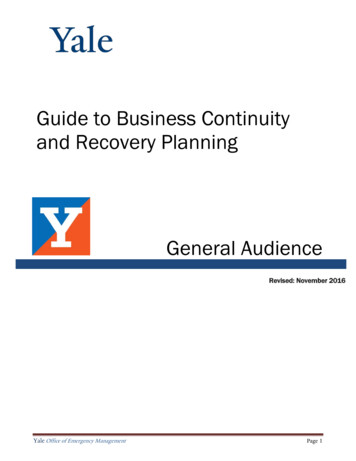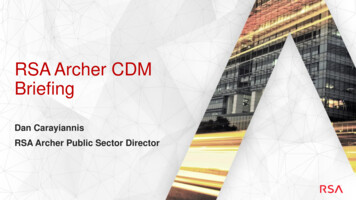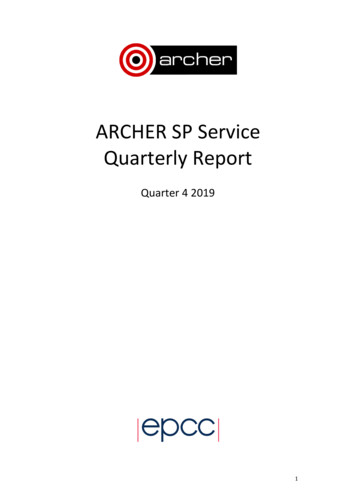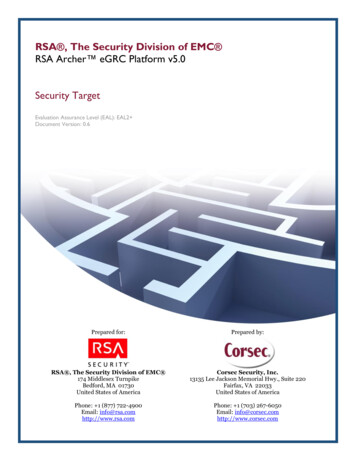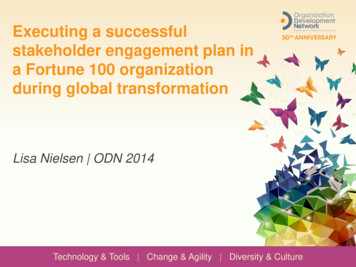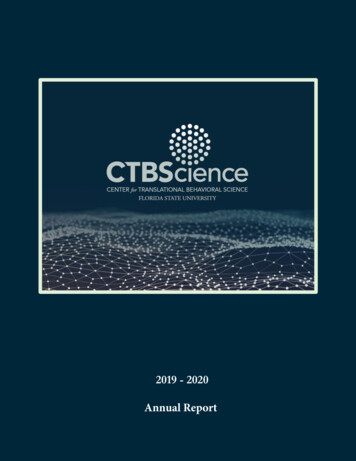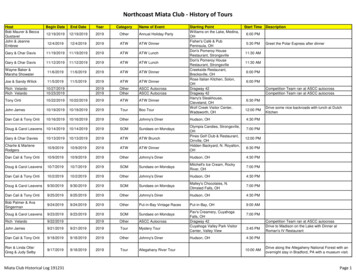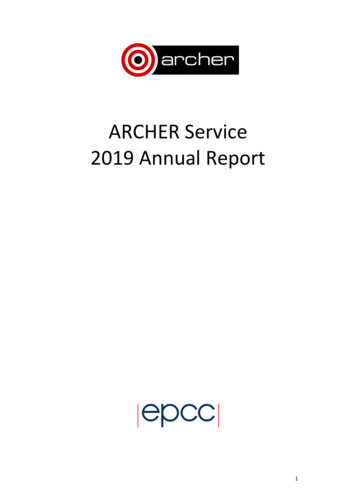
Transcription
ARCHER Service2019 Annual Report1
Document Information and Version HistoryVersion:Status1.0ReleaseAlan Simpson, Anne Whiting, Chris Johnson, Xu Guo, Andy Turner,Felipe Popovics, Steve Jordan, Harvey Richardson, Linda Dewar, LornaSmithAuthor(s):Reviewer(s)VersionAlan Simpson, Lorna SmithDateComments, Changes, 3-312020-04-072020-04-082020-04-10Inputting initial informationAdditional informationAddition of Cray CoE textAdditional text and reviewMinor correctionsText from Cray Systems0.71.02020-05-012020-05-05ReviewedVersion for the AuthorityAuthors, contributors,reviewersAnne WhitingLorna SmithHarvey RichardsonLorna SmithAnne WhitingFelipe Popovics, SteveJordanAlan SimpsonAlan Simpson2
Table of ContentsDocument Information and Version History .2Table of Contents .31.Introduction .42.Executive Summary .53.Service Utilisation .64.5.6.7.8.3.1Overall Utilisation .63.2Utilisation by Funding Body.63.3Additional Usage Graph .7User Support and Liaison (USL) .84.1Helpdesk Metrics .84.2USL Service Highlights .8HPC Systems Group (HPCSG) . 105.1Service failures. 105.2Principal activities undertaken. 10Computational Science and Engineering (CSE) . 116.1Business Continuity and Disaster Recovery Scenario . 116.2Demonstrating benefit to the community from the eCSE programme. 116.3Continual Service Improvement (CSI) on ARCHER. 126.4Towards a shared UK HPC knowledge base. 12Cray Service Group . 157.1Summary. 157.2Reliability and performance . 157.3Scheduled maintenance activities . 15Cray Centre of Excellence (CoE) . 168.1The LASSi framework and related work. 168.2Events attended . 178.3Significant investigations . 178.4ARCHER queries and software. 188.5Support of the eCSE programme . 183
1. IntroductionThis annual report covers the period from 1 Jan 2019 to 31 Dec 2019.The report has contributions from all of the teams responsible for the operation of ARCHER; Service Provider (SP) containing both the User Support and Liaison (USL) Team and the HPCSystems Group; Computational Science and Engineering Team (CSE); Cray, including contributions from the Cray Service Group and the Cray Centre of Excellence.The next section of this report contains an Executive Summary for the year.Section 3 provides a summary of the service utilisation.Section 4 provides a summary of the year for the USL team, detailing the Helpdesk Metrics andoutlining some of the highlights for the year.The HPC Systems report in Section 5 describes their four main areas of responsibility; maintainingday-to-day operational support; planning service enhancements in a near-to-medium timeframe;planning major service enhancements; and supporting and developing associated services thatunderpin the main external operational service.In Section 6 the CSE team describe a number of highlights of the work carried out by the team in2018.In Sections 7 and 8, the Cray Service team and Cray Centre of Excellence give a summary of theiryear’s activities, respectively.This report and the additional SAFE reports are available to view online 2018.php4
2. Executive SummaryThe sections from the various teams describe highlights of their activities. This section gives a briefsummary of highlights from the last year of the overall ARCHER service. More details are provided inthe appropriate section of the document. The ARCHER system continued to be busy, with utilisation over the year at 88%. A total of7,246 queries were answered by the Service Provider with 99% resolved within 2 days.EPCC passed a four-day combined external audit of ISO 9001 Quality Management and ISO27001 Information Security Management. This ensures EPCC delivers the best and mostsecure service to our users.A Business Continuity and Disaster Recovery (BCDR) scenario test was carried out in October.There were no interruptions to service and the user community was unaware that it hadtaken place. This test helps prepare our staff and to improve our processes to ensure wekeep the services running as best we can in case of major incidents in the future.In order to facilitate faster data movement to the RDF GPFS filesystems from the ARCHERlogin nodes, the existing bonded pair of 10gbit links from the ARCHER core switches to theRDF sitewide network has been upgraded to a pair of 40gbit links. The increase in transferspeed will assist users in transferring data from ARCHER to the RDF.The ARCHER eCSE programme has provided funding to the ARCHER user community todevelop software in a sustainable manner to run on ARCHER and on future Tier-1 services. Todate cumulative benefits of almost 35M have been shown using our benefits realisationtechniques, representing a 5-fold return on investment.With the wealth of national HPC facilities available for researchers to choose from for theircomputational work (ARCHER, DiRAC, Tier-2 HPC), we have performed a significant amountof work comparing the performance of HPC applications across different platforms. This workhas resulted in a public repository of benchmarks.Recently, the ARCHER CSE service has led an initiative that coordinates with HPC Championsand the wider HPC RSE community to consider how we could create a community UK HPCtechnical knowledge base that would allow us to share and reuse useful technicalinformation and experience.In 2019, the CoE took further advantage of our LASSi I/O analysis framework both inanalysing user problems and to support studies into I/O usage of applications andcommunities on ARCHER.5
3. Service Utilisation3.1 Overall UtilisationUtilisation over the year was 88%, up slightly from 86% in 2018.3.2 Utilisation by Funding BodyThe utilisation by funding body relative to their allocation can be seen below.This bar chart shows the usage of ARCHER by the two Research Councils presented as a percentage ofthe total Research Council allocation on ARCHER.6
3.3 Additional Usage GraphThe following heatmap provides a view of the distribution of job sizes on ARCHER throughout 2019.The heatmap shows that most of the kAUs are spent on jobs between 192 cores and 3,072 cores (8 to128 nodes). The number of kAUs used is closely related to money and shows how the investment inthe system is utilised.7
4. User Support and Liaison (USL)4.1 Helpdesk MetricsQuery ClosureIt was a busy year on the Helpdesk with all Service levels met. A total of 7,246 queries were answeredby the Service Provider, up from 6,551 queries during 2018. 99% were resolved within 2 days. Inaddition to this, the Service Provider passed on 141 in-depth queries to CSE and Cray.Self-Service AdminAdminTechnicalTotal 0769146519Q41365337461748TOTAL561113822537246Other QueriesIn addition to the Admin and Technical Queries detailed above, the Helpdesk also dealt with Phonequeries, Change Requests, internal requests and User Registrations.Phone Calls ReceivedChange RequestsUser Registration TAL22110976It is worth noting that the volume of telephone calls was low throughout the year (221 calls). Allphone calls were answered within 2 minutes, as required.4.2 USL Service HighlightsUser Survey 2018The results of the 2018 annual ARCHER User Survey were run in February 2019. 188 responses werereceived compared to 164 in 2017, 161 in 2016, 230 in 2015 and 153 in 2014, with the mean resultsshown below (scores 1 representing “Very Unsatisfied” and 5 representing “Very Satisfied”):Service ocumentationWebsiteTrainingWebinarsOnline Training2014 MeanScore (out of5)4.42015 MeanScore (out of5)4.32016 meanScore (out of5)4.32017 meanScore (out of5)4.42018 meanScore (out 23.93.84.54.04.04.33.93.9As with previous years the highest mean score was achieved by the Helpdesk (4.5). Mean satisfactionhad risen from 4.4 in 2017 to 4.5 in 2018, the highest overall satisfaction score for the service to date.The full report can be found at http://www.archer.ac.uk/about-archer/reports/.8
Combined ISO 27001:2013 and ISO 9001:2015 Certification SuccessEPCC was delighted to be able to announce that they have passed a four-day combined external auditof ISO 9001 Quality Management and ISO 27001 Information Security Management. ARCHER andCirrus, our Tier-2 service, are both in scope for these certifications. The success in achieving thesecertifications reflects the importance we place on delivering the best and most secure service to ourusers and to taking action on feedback received to improve our service.BCDR Scenario TestA Business Continuity and Disaster Recovery (BCDR) scenario test was carried out in October. Theaims of the test are to verify the processes in place, identify improvements and to ensure that staffhave had the necessary training to ensure that should such an event occur we can maintain anuninterrupted service to our users. More details of this successful scenario test are given in the CSEsection.Running weekend queue during the Christmas holidaysTo contribute to the utilisation of ARCHER over the holidays, the weekend queue was in operation forthe whole of the festive period. The use of the weekend queue contributed to ensuring a higherutilisation of ARCHER during the holiday period, with utilisation in December 2019 at 94% comparedto 80% and 72% in December 2018 and December 2017 respectively.Preparation for the end of the ARCHER2 serviceA data migration webinar was run several times to provide assistance for the user community inplanning the data migration required for ARCHER2. The recording was made available on the ARCHERwebsite and the data migration guide has been updated with the same guidance information.SAFE improvementsAfter user feedback received, two new reports were added to SAFE to enable users and group leadersto run the Cray Lassi reports to show parallel IO use by user and by group. The data includes asummary of data written and read, and statistics from individual jobs giving data written and read andwrite operations.9
5. HPC Systems Group (HPCSG)5.1 Service failuresThere were no SEV1 Service Failures attributable to SP in the period as defined in the metric.5.2 Principal activities undertakenIn addition to day-to-day operational activities, principal activities undertaken included the following:Minimising user disruption through reduced numbers of maintenance outagesHPCSG has continued its efforts to reduce the number of planned maintenance sessions and thus thedisruption to the service for users with a particular aim to provide stability for ARCHER towards theend of service.Wherever possible, tasks are now carried out at risk rather than requiring a systems outage, andwhere planned outages are required these are taken jointly with Cray to minimise user disruption.In 2019, only one full maintenance session was taken, compared with 4 in 2018 and 7 in 2017.Working with Cray staff to maintain and improve ARCHER and reduce risk of service interruptionHPCSG worked closely with the Cray team to keep the system patched, applying field notices andpatch sets according to Cray recommendations. Improvements have been made to the systemmonitoring tools used in order to proactively resolve issues before they become user or systemaffecting.Scheduler UpgradeThe PBS scheduler was upgraded from version 12.2.401 to 13.0.412 enabling users to benefit from thenew features offered.Faster data movement to the RDFIn order to facilitate faster data movement to the RDF GPFS filesystems from the ARCHER login nodes,the existing bonded pair of 10gbit links from the ARCHER core switches to the RDF sitewide networkhas been upgraded to a pair of 40gbit links. The increase in transfer speed will assist users intransferring data from ARCHER to the RDF.10
6. Computational Science and Engineering (CSE)6.1 Business Continuity and Disaster Recovery ScenarioThe CSE and SP teams ran a joint test of ISO-9001 Business Continuity and Disaster Recoveryprocesses on Tuesday 8th October. This is in line with our commitment to run a full and realisticscenario, as part of continual service improvement, every two years.This particular test was based around a scenario in which a significant portion of the team wasaffected by food poisoning and unable to work at short notice, following on from an EPCC workfunction. The test was very successful: Staff involved are confirmed to be better equipped to deal with any real major incident thatmay occur.There was no impact on the actual ARCHER service.Lessons learned from the previous test were confirmed to have been implementedeffectively.A set of recommended improvements have been agreed as an outcome of the test.A detailed report on the preparation, execution, and outcomes of the test has been produced andshared with UKRI. A set of potential improvements were identified in the course of the test, includinga review of interfaces to other University of Edinburgh agencies and an update to induction materialfor new staff to give sufficient emphasis to business continuity planning and testing.This test and the previous one demonstrate the benefits of regular BCDR testing, and encourage morefrequent testing. Consideration is being given to running different types of BCDR testing that could berun more frequently. For example, a table-top exercise to review the response to various majorincident scenarios.6.2 Demonstrating benefit to the community from the eCSE programmeThe ARCHER eCSE programme has provided funding to the ARCHER user community to developsoftware in a sustainable manner to run on ARCHER and on future Tier-1 services. The programme ranthroughout the ARCHER service with 13 calls receiving 222 proposals leading to 100 awarded projects.It was set up to provide at least 14 FTEs (8.4 FTEs in the final year) of effort embedded across the UKARCHER community and ran as a not-for-profit service with any remaining money used to fund extraperson months. In the end the programme funded 973 person months of effort which included anextra 32 person months from the remaining funds.Projects are not funded to do scientific research itself, but instead focus on software developmentswhich lead to a number of tangible improvements; these in turn aid researchers’ abilities to carry outtheir scientific research. Many of these improvements can be quantified to show the return oninvestment using benefits realisation techniques developed during the programme. For example,using data on how much faster a code runs it is possible to compare how much code usage wouldhave cost before and after the code improvements. From this comparison it is possible to see howmuch cost saving a project has provided in financial terms.To date cumulative benefits of almost 35M have been shown using our benefits realisationtechniques. The programme as a whole cost almost 7M to run therefore showing around a 5-foldreturn on investment, a figure which will continue to grow as further usage of the improved codesbrings further cost savings.11
6.3 Continual Service Improvement (CSI) on ARCHERIn collaboration with user groups and the other Service partners, the CSE service identified severalpriority service improvement areas to invest technical effort from the centralised CSE team. This sectionprovides highlights of the CSI projects implemented in 2019.Benchmarking MPI performance on UK HPC facilitiesWith the wealth of national HPC facilities available for researchers to choose from for theircomputational work (ARCHER, DiRAC, Tier-2 HPC), we performed a significant of work comparing theperformance of HPC applications across different platforms. This work has resulted in a publicrepository of benchmarks, results and performance analysis and two reports on application benchmark performance to help users choose the correct facility fortheir research (https://doi.org/10.5281/zenodo.1288378, andhttps://doi.org/10.5281/zenodo.2616549). The next step is to provide more information on theperformance differences seen on different platforms. As all of the application benchmarks (and theoverwhelming majority of parallel HPC applications) use the MPI library to implement their distributedmemory parallelism, understanding the performance of MPI libraries across the different HPC platformsis critical to understanding the
A Business Continuity and Disaster Recovery (BCDR) scenario test was carried out in October. The aims of the test are to verify the processes in place, identify improvements and to ensure that staff
